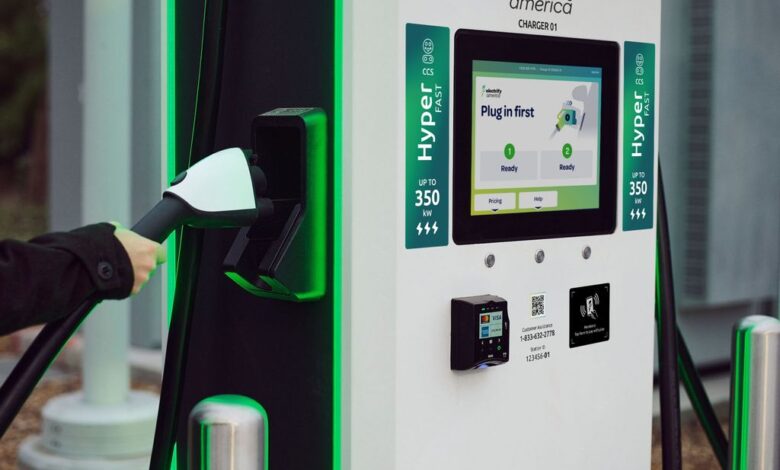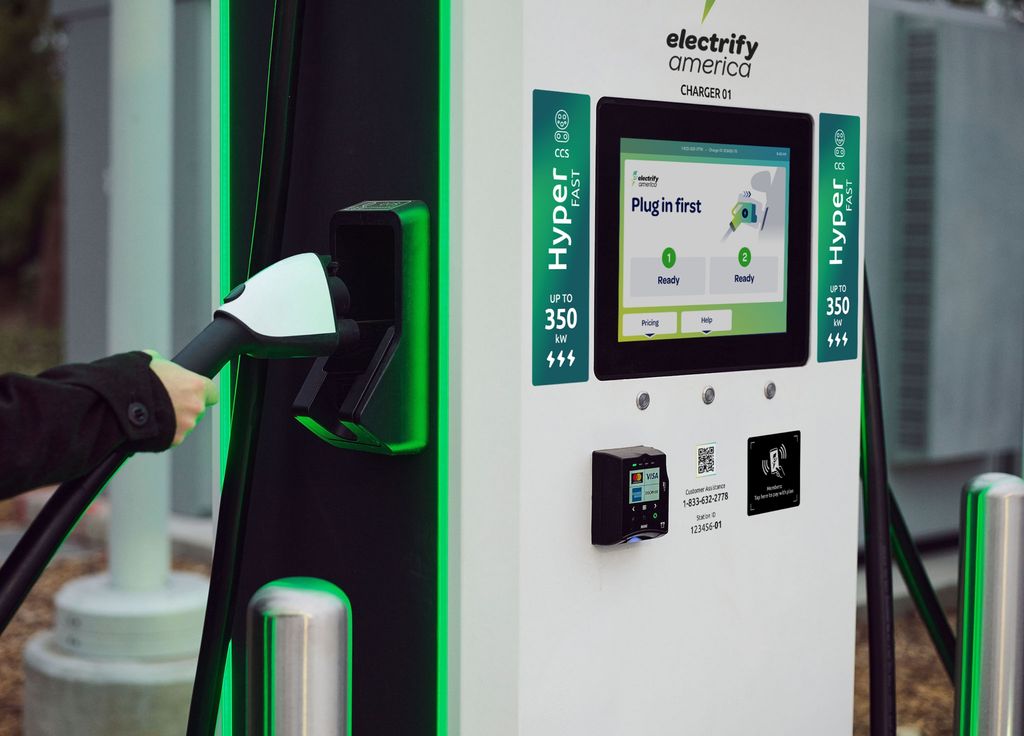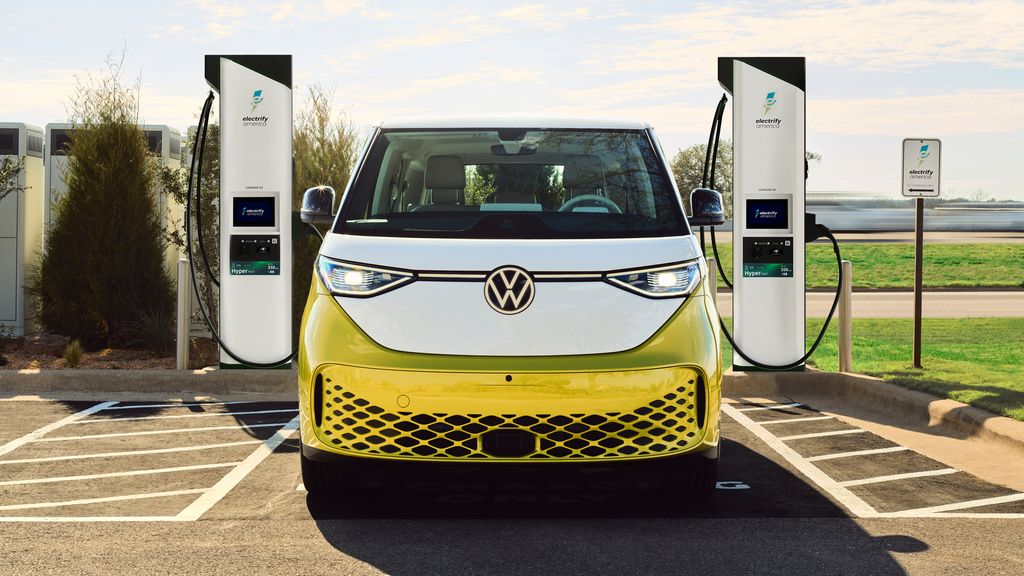Why This EV Charging Network Is Doubling Down In The Trump Era

In just a few short months, President Donald Trump and his Republican-controlled Congress have blown a hole in the electric vehicle industry’s growth plans. With EV tax credits being phased out and tailpipe emissions regulations on the chopping block, we’re going to see far fewer electric cars hit the road in the coming years than previously expected.
That radically shifted outlook has had ripple effects across the EV industry, with automakers from Honda to Nissan canceling or delaying new models. But there’s one bright spot so far: Despite everything, the rapid buildout of EV fast chargers across the country isn’t letting up.
To get a sense of how one of the country’s largest EV charging companies is tackling this current moment, I called up Electrify America’s senior director of sales and marketing, Rachel Moses.
The bottom line? Despite some very real obstacles and a lot of noise, Electrify America isn’t pumping the brakes on its expansion plans one bit.

Electrify America says it isn’t changing the pace of its buildout despite a challenging EV market.
Photo by: Electrify America
“Even though we are at this weird time where there are industry headwinds, it is also a really exciting time,” she told me. “Whilst there are market shifts, it’s not detrimental, perhaps, to the extent of which the noise is out there.”
Electrify America isn’t alone in keeping its foot on the accelerator. The U.S. is on track to put 16,700 new public chargers in the ground this year, a new record and a roughly 20% gain over last year’s deployments, according to the charging data firm Paren. Through the first half of this year, charging networks opened some 1,500 new locations in the U.S.
This is a win for both current and future EV owners. Concerns around access to charging infrastructure have consistently held back wider EV adoption. More stations and plugs out there could help entice more Americans to make the switch—particularly those who don’t have a garage to charge in.

EV sales will keep growing, creating demand for its charging stations, the company says.
Photo by: Electrify America
And it’s those new buyers that make Moses confident in Electrify America’s growth strategy.
Even if EV sales don’t grow as quickly over the next few years as they could have under the previous policy environment, millions more electric cars will hit the road. Those people will demand more and more charging options.
“Electrify America alone, one company, will not meet that demand. And so, in all of us together, I don’t think there’s any breathing room,” she said. “I think we all have to continue to make sure that we are investing to close that gap and to keep our pace of growth.”
The company’s forecast for EV market growth is “not as aggressive” in the next 2-3 years, but picks up after that, she told me. The last couple of years also hint at what the future holds for charging demand.
Over the last 18 months or so, EV sales growth has downshifted as early adopters gave way to more hesitant mainstream buyers. U.S. EV sales grew by a modest 7% in 2024 to hit 1.3 million units, after shooting up 46% in 2023. And yet, Electrify America says it dispensed over 600 gigawatts of energy in 2024, a 65% increase year-over-year. It logged 16 million charging sessions last year, up from 11 million in 2023.
“What we’re seeing is that that continues to increase. And that is a reflection of the attractiveness of the vehicles, the volume of vehicles that are still being sold,” Moses said.

Electrify America is focused on building larger stations in urban areas.
Photo by: Electrify America
What about the National Electric Vehicle Infrastructure program, or NEVI? This $5 billion project, passed under the Biden administration, funds the buildout of fast chargers along highways. Then the Trump administration came in and froze the funds for months, throwing the program into chaos. In June, a federal judge ordered the DOT to unfreeze the funds after 16 states sued. It’s still in legal limbo.
According to Moses, Electrify America did win some NEVI money, mostly on behalf of its commercial clients that it sells turnkey charging solutions to. “For the most part,” she says, those projects are receiving the funds they were awarded. The majority of the company’s own NEVI-funded projects are also underway, she said, though there is “a little bit of uncertainty.”
She says the NEVI funding is nice to have, but not make or break for Electrify America’s business.
“We continue to want to see that money being allocated and being spent for those projects, but the federal incentives themselves are not what our business is based on,” she told me. “So it hasn’t had a direct negative consequence to our longevity and our business model and how we continue to grow and expand.” (To be sure, some smaller EV charging startups are more impacted by Trump’s funding cuts and freezes, as Heatmap News reported this week.)

The company is replacing old chargers that created reliability problems.
Photo by: Electrify America
So what exactly does that growth and expansion look like?
After initially focusing on building out locations along highways when it launched in 2017, Electrify America is now zeroing in on bigger stations in urban areas. That means at least 10 chargers per site from now on—save for some smaller ones that are already in development—to help alleviate the lines that form at some of its busiest stations.
It’s also investing in upgrading old hardware that Moses says wasn’t up to snuff and contributed to reliability issues. It’s replaced around 1,800 chargers over the last 18 months. And it’s starting to expand its stations with the North American Charging Standard, or NACS, the Tesla-designed charging plug that is becoming the industry standard.
The company has two stations with NACS connectors right now: one in Florida and one in Connecticut. It’s evaluating the customer experience there and getting a sense of automakers’ plans for NACS-equipped models before deciding where else to install the plugs and how quickly to do it.
“We are committed to embracing the standard. There’s no concern from that perspective,” she said. “It’s about how we are deploying it and at what scale, at what time.”
The rough waters ahead for the EV industry are nothing to sneeze at. But for Moses, a 16-year veteran of the space, they aren’t entirely new either.
“We’ve seen these ups and downs in this industry over the last 15, 20 years, as long as it’s been a commercialized industry,” she said.
Contact the author: Tim.Levin@InsideEVs.com
Source link
